Overview
A yoga chart for beginners is a visual guide that outlines various postures, helping newcomers learn proper alignment and enhance their practice effectively. The article emphasizes that such charts not only provide essential instructions and modifications for different skill levels but also foster confidence and reduce the risk of injury, ultimately contributing to a more enjoyable and beneficial yoga experience.
Introduction
In the quest for holistic well-being, yoga stands out as a transformative practice that nurtures both body and mind. For those embarking on this journey, yoga charts serve as invaluable tools, guiding beginners through the myriad of poses with clarity and confidence. These visual aids not only simplify the learning process but also enhance understanding of proper alignment and the physical benefits associated with each posture.
As practitioners delve into the world of yoga, they discover that these charts can empower them to cultivate strength, flexibility, and emotional balance, all while fostering a sense of community and support. By integrating yoga into workplace wellness initiatives, organizations can inspire their teams to embrace healthier lifestyles, ultimately leading to a more productive and engaged workforce.
This article explores the significance of yoga charts, the essential poses for beginners, and practical tips to maximize their use, paving the way for a rewarding and enriching yoga experience.
Understanding Yoga Charts: A Beginner's Guide
A fitness guide acts as a crucial visual reference that details a range of postures, accompanied by illustrations that show proper alignment and stance. For individuals beginning their practice, the yoga chart for beginners is an essential guide. They provide a structured framework for learning and practicing, which includes a yoga chart for beginners to explore the varied range of positions and their associated benefits.
By using a practice guide, individuals can develop confidence and confirm they are performing poses correctly, which is essential for avoiding injuries and obtaining the full benefits of their routine. Furthermore, the yoga chart for beginners often provides modifications to accommodate various skill levels, making the practice accessible to all. Recent findings show that a significant number of practitioners participate in this practice to release tension (54%), increase strength (52%), and enhance happiness (43%).
Importantly, 53% of women reported ease of menstrual symptoms with regular practice of the discipline, highlighting another key benefit. Incorporating mindfulness practices into workplace wellness programs can empower employees to embrace these benefits, fostering a healthier and more productive environment. Remember, while this practice can enhance well-being, it should never substitute doctor-recommended medical treatment with complementary or alternative therapies.
Beginners are encouraged to explore various styles of practice, such as:
- Hatha
- Vinyasa
- Bikram
- Ashtanga
- Iyengar
- Restorative forms
using a yoga chart for beginners for proper instruction.
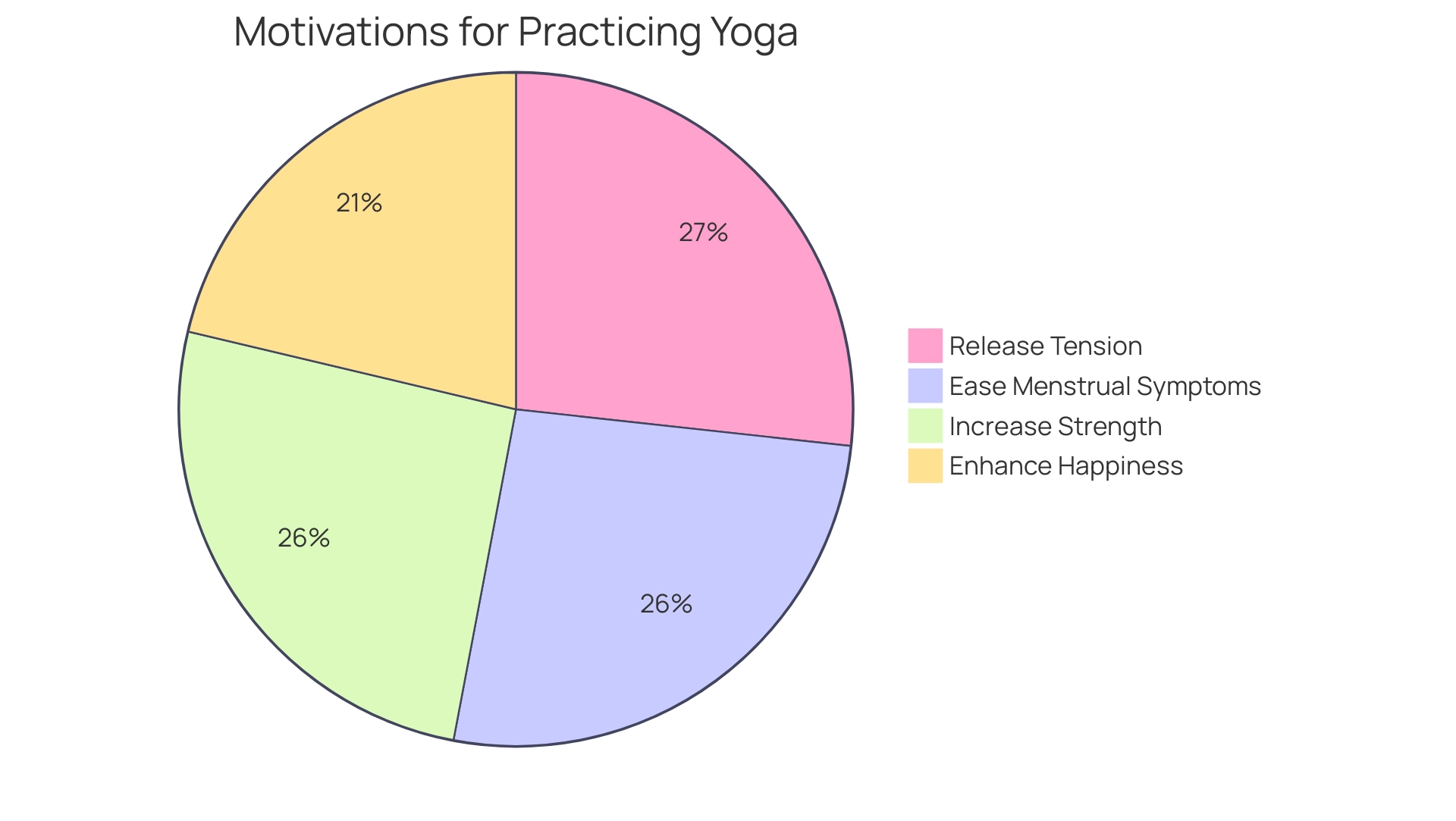
The Benefits of Using a Yoga Chart for Beginners
Adopting the use of visual aids can profoundly change the experience of newcomers in their practice. These diagrams provide a systematic method that streamlines the learning experience, enabling new practitioners to maneuver through the extensive variety of positions and sequences effortlessly. By reducing the initial stress that frequently comes with beginning this activity, they enable individuals to concentrate on their routine without the weight of doubt.
Moreover, the yoga chart for beginners enhances understanding by clearly illustrating the physical benefits of each position, emphasizing the importance of alignment and breathing techniques. This yoga chart for beginners serves as a motivational tool, inspiring practitioners to explore new poses and deepen their understanding while also encouraging consistency in their routines. Consistent engagement is crucial; studies, such as Verma et al. (2014), involving 82 middle and high school students participating in Hatha Yoga, have shown that regular practice can lead to significant improvements in flexibility, strength, and mental clarity. Additionally, a randomized controlled trial titled 'Yoga for Emotional and Behavioral Functioning' demonstrated that this practice positively impacts emotional and behavioral functioning compared to traditional physical education. This evidence supports the notion that structured learning through a yoga chart for beginners can be especially beneficial.
Furthermore, the recommendation for additional qualitative research on the practice's effects in diverse populations underscores the importance of understanding how structured learning can be tailored to various demographics. As one participant beautifully expressed,
- 'I feel like a swan while practicing, the climax of emotions, elegant movements, movements as if you are evolving into nature.'
This eloquence captures the transformative power of the practice, making it an invaluable addition to any wellness initiative aimed at enhancing team well-being.
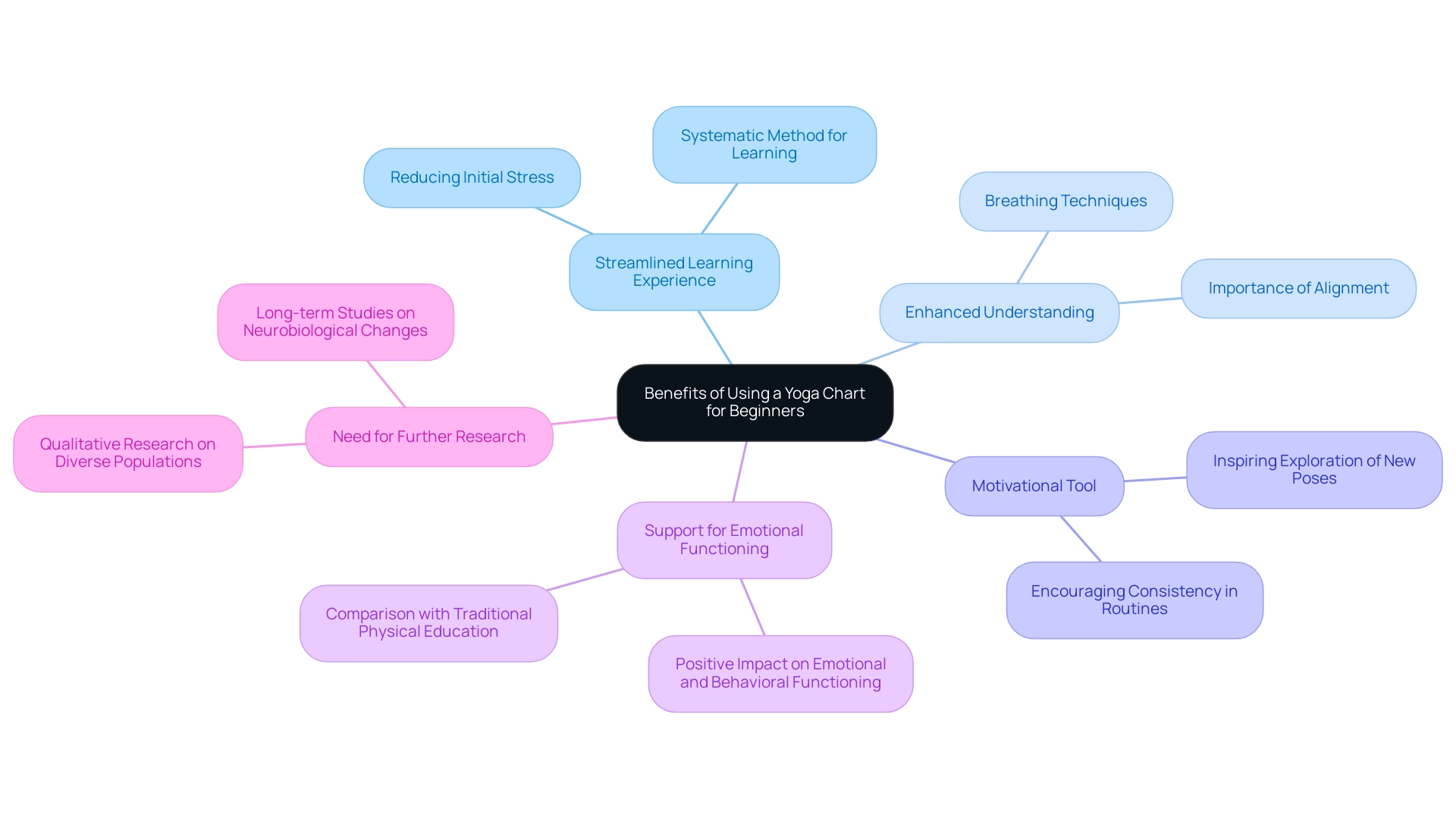
How to Effectively Use a Yoga Chart in Your Practice
To truly harness the benefits of yoga in your routine, start by choosing a yoga chart that aligns with your experience and personal goals. Position it prominently in your practice space, ensuring it remains a visible reminder of your commitment to well-being. Start with a select few positions, dedicating your focus to perfecting their alignment and transitions before advancing to more complex postures.
Incorporating the diagram into both your warm-up and cool-down routines offers a structured method to reflect on your progress and growth. Additionally, utilizing a timer to maintain positions for the prescribed durations can significantly enhance your endurance and physical capabilities. Consistently reviewing the yoga chart for beginners not only helps monitor progress but also ignites enthusiasm to discover new positions as you advance in your practice.
This method not only promotes personal development but also illustrates the transformative effect that this practice can have on overall well-being. Studies have shown that individuals practicing gentle poses for at least 30 minutes weekly experience significantly healthier lifestyle choices, including a 50% lower likelihood of alcohol consumption (OR = .621). As John Schumacher observes, incorporating organized activities into daily routines can improve overall wellness and productivity.
By integrating mindfulness practices into employee wellness programs, HR Benefits Managers can contribute to a healthier, more engaged workforce. Complementing the practice with Foresight Health Coaching's tailored wellness programs—which include in-person wellness talks, comprehensive pantry and nutrition services, and access to our health and wellness app—can further enhance employee well-being. Foresight offers comprehensive coaching services designed specifically for corporate groups, ensuring that your team's health journey is supported holistically.
Additionally, our workshops can be incorporated into exercise routines, enabling employees to enhance their understanding and skills in wellness. Prioritize your team's well-being today by incorporating both exercise and tailored wellness coaching into your employee health strategies.
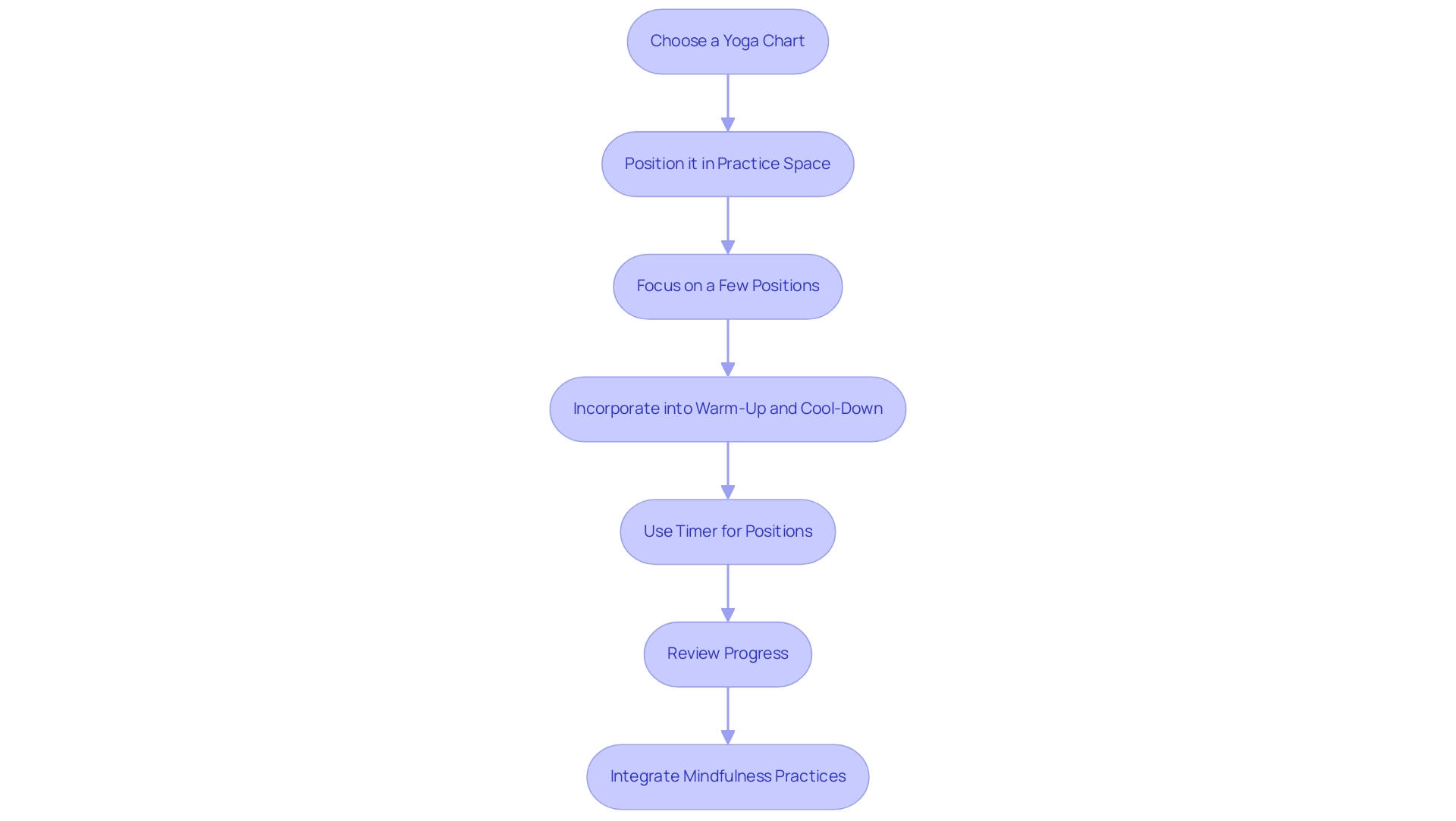
Essential Yoga Poses for Beginners: What to Look for in a Chart
For novices, using a yoga chart for beginners reveals fundamental positions that serve as the foundation of numerous routines. Key positions such as:
- Mountain Position (Tadasana)
- Downward-Facing Dog (Adho Mukha Svanasana)
- Child’s Position (Balasana)
- Warrior I (Virabhadrasana I)
not only enhance strength, flexibility, and balance but also provide a solid foundation for future progress in the practice. As Amanda Capritto, an expert in the field, observes,
It is, after all, an ancient practice with roots dating as far back as 5,000 years ago in Northern India.
These basic positions are not only adaptable; they are essential to different forms of practice, making them perfect for any novice. A well-designed yoga chart for beginners will not only highlight these key poses but also provide modifications to accommodate different skill levels. This inclusivity guarantees that every practitioner can discover their ideal entry point into the field, contributing to their overall well-being.
Moreover, with the rise of online fitness classes, accessible for as little as $45, individuals can conveniently practice at home. These classes cater specifically to those who prefer practicing in a familiar environment, making this practice more accessible to a broader audience. Additionally, it's noteworthy that 38% of instructors spend between $1,000 and $5,000 on continuing education each year, reflecting their commitment to professional development and enhancing the quality of instruction.
By dedicating just 30 minutes a day to these essential positions, practitioners can develop core strength and witness significant positive transformations in their bodies, reinforcing the advantages of a regular routine.
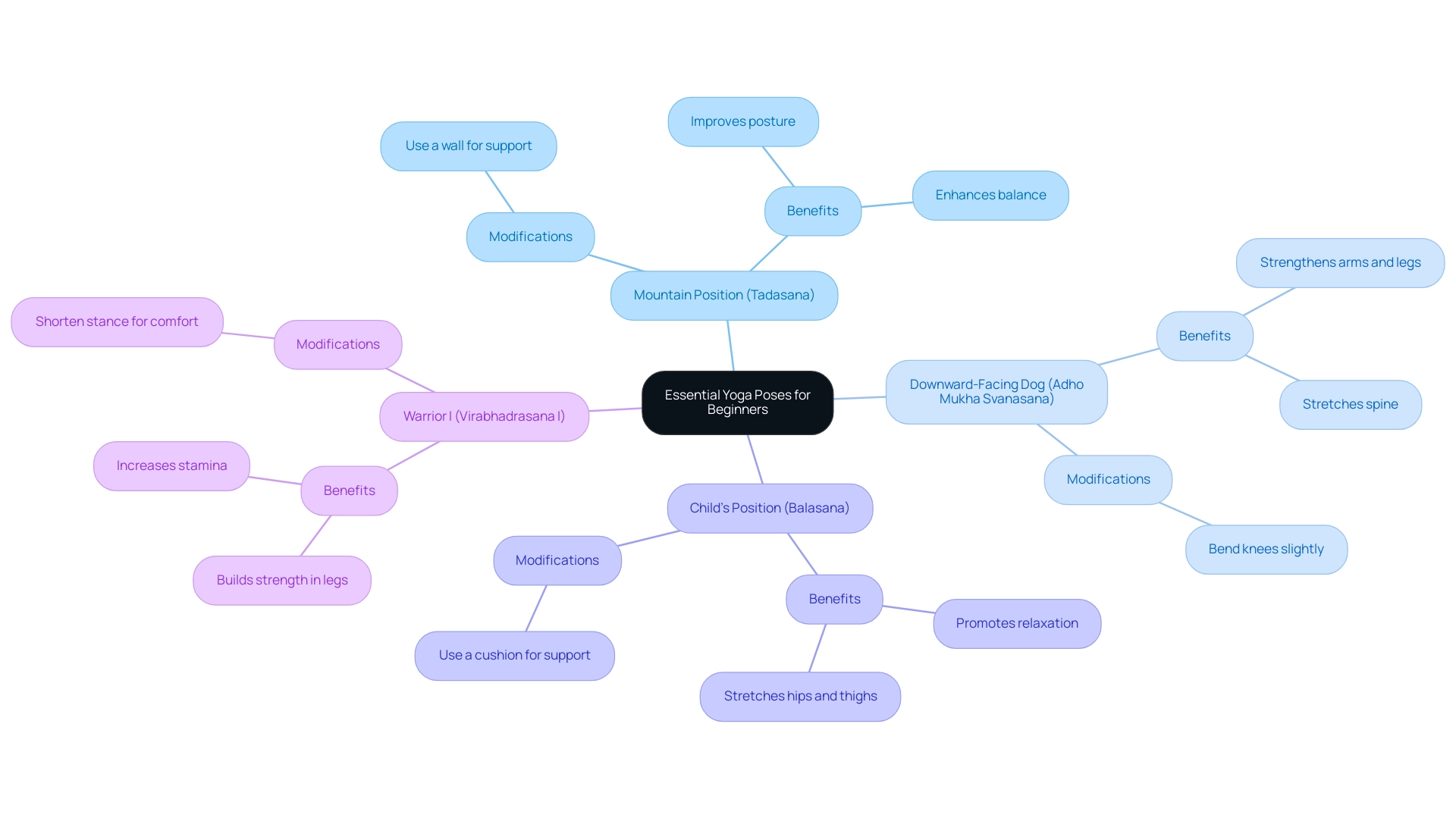
Tips for Beginners: Making the Most of Your Yoga Chart
To fully utilize the yoga chart for beginners, start by engaging with its layout and the positions it specifies. Familiarizing yourself with the images and alignment notes is crucial, as this knowledge will support your practice. As you begin your practice, set attainable objectives—such as mastering one new position each week—and take time to celebrate each milestone, regardless of how minor.
This approach fosters a sense of accomplishment and keeps motivation high. Additionally, consider journaling after each session, capturing your reflections on what felt empowering and which positions challenged you. This method not only improves your understanding but also strengthens your bond to this personal journey.
Remember, progress in this practice is not measured solely by the poses mastered but by the growth and self-discovery you experience along the way. As Amanda Capritto notes, "It is, after all, an ancient practice with roots dating as far back as 5,000 years ago in Northern India." The growing significance of this practice in wellness programs is highlighted by the anticipated expansion of the African market for it at a CAGR of 8% through 2027.
Furthermore, the global interest in yoga is evident, with India experiencing a 30% increase in yoga tourism over the last five years, highlighting the growing participation trends that HR Benefits Managers should consider when implementing wellness initiatives.
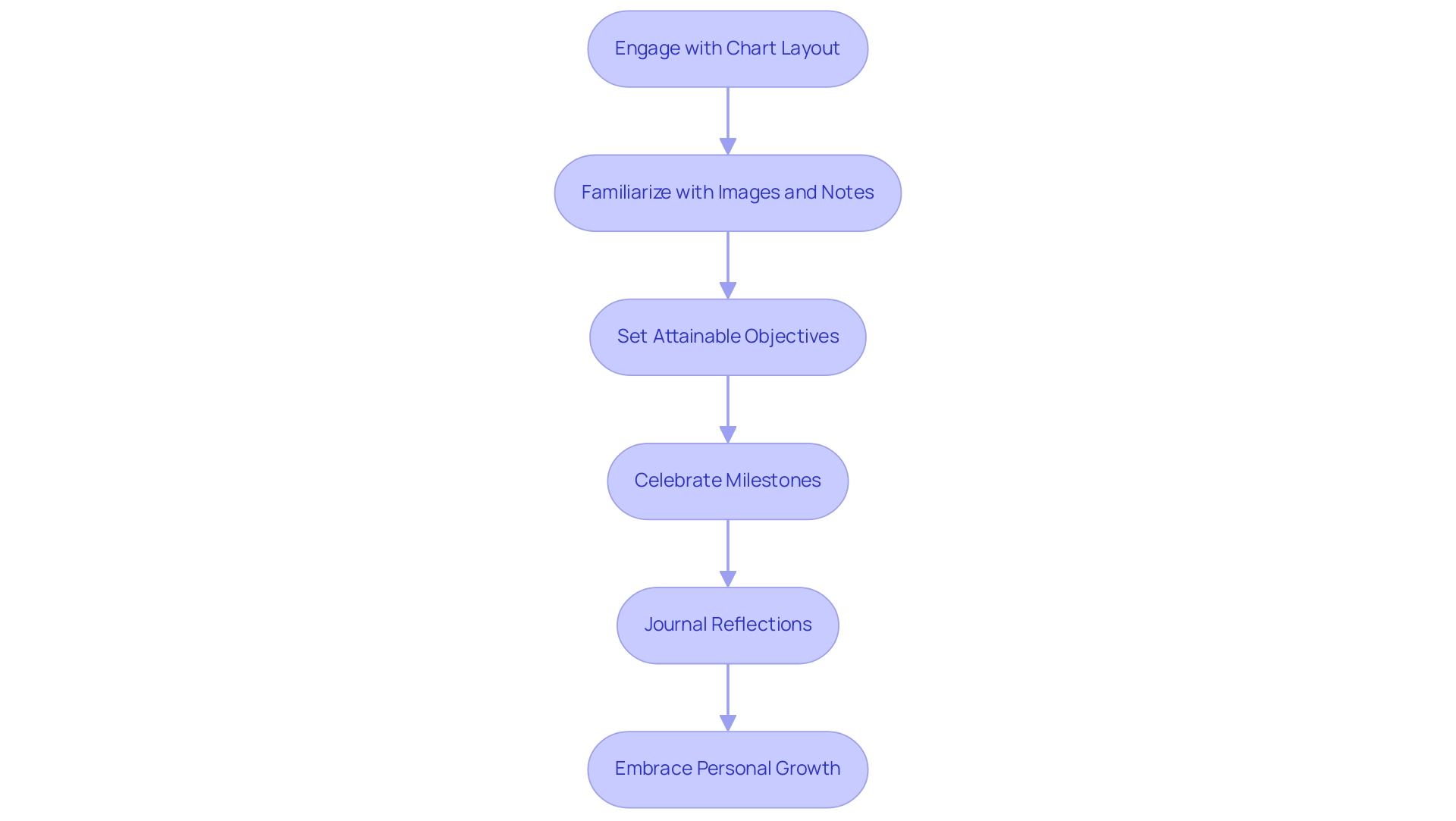
Conclusion
Incorporating yoga charts into the practice of beginners can significantly enhance their journey toward holistic well-being. These visual tools not only provide clear guidance on essential poses but also foster a deeper understanding of the benefits associated with each posture. By emphasizing proper alignment and offering modifications, yoga charts make this transformative practice accessible to all, empowering individuals to embark on their wellness journey with confidence.
The benefits of implementing yoga in workplace wellness programs are profound. As research indicates, regular yoga practice can lead to improvements in physical health, emotional balance, and overall productivity. By prioritizing yoga as part of employee health strategies, organizations can cultivate a supportive environment that encourages healthier lifestyle choices, ultimately contributing to a more engaged and resilient workforce.
As the popularity of yoga continues to grow, the integration of structured practices such as yoga charts into daily routines is increasingly vital. With the right approach, organizations can inspire their teams to embrace this enriching practice, fostering a culture of well-being that benefits everyone involved. Now is the time to take action and make yoga an integral part of workplace wellness initiatives, paving the way for a healthier future for all.
Frequently Asked Questions
What is the purpose of a fitness guide in yoga practice?
A fitness guide acts as a crucial visual reference detailing a range of postures, with illustrations showing proper alignment and stance, which helps individuals learn and practice yoga effectively.
Why is a yoga chart for beginners important?
The yoga chart for beginners provides a structured framework for exploring various positions and their benefits, helping newcomers develop confidence and ensure they perform poses correctly to avoid injuries.
What benefits do practitioners seek from yoga?
Practitioners participate in yoga to release tension (54%), increase strength (52%), enhance happiness (43%), and 53% of women reported relief from menstrual symptoms with regular practice.
How can mindfulness practices, such as yoga, benefit workplace wellness?
Incorporating mindfulness practices into workplace wellness programs can empower employees to embrace the benefits of yoga, fostering a healthier and more productive environment.
What styles of yoga should beginners consider exploring?
Beginners are encouraged to explore various styles, including Hatha, Vinyasa, Bikram, Ashtanga, Iyengar, and Restorative forms.
How do visual aids like yoga charts enhance the learning experience for newcomers?
Visual aids provide a systematic method that streamlines the learning experience, reducing initial stress and allowing individuals to focus on their routines without doubt.
What are the physical benefits of regular yoga practice?
Regular practice can lead to significant improvements in flexibility, strength, and mental clarity, as supported by studies involving students participating in Hatha Yoga.
What is the significance of structured learning through yoga charts?
Structured learning through yoga charts can be especially beneficial for understanding poses, emphasizing alignment and breathing techniques, and inspiring consistency in routines.
What is suggested for future research regarding yoga practice?
There is a recommendation for additional qualitative research on the practice's effects in diverse populations to better understand how structured learning can be tailored to various demographics.

